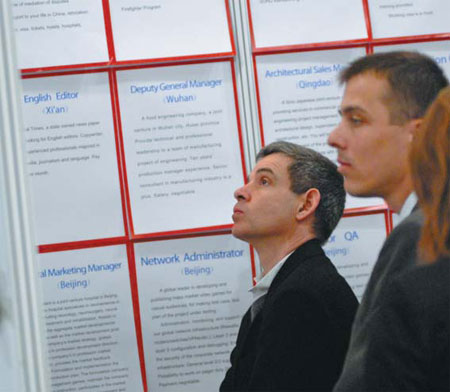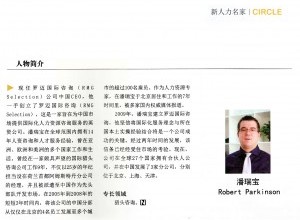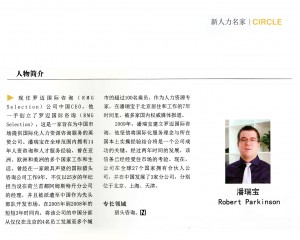 In the world of headhunting, carefully assessing personalities plays a role. Provided to China Daily In the world of headhunting, carefully assessing personalities plays a role. Provided to China Daily |
The refined techniques of recruitment firms are in demand. An increasing number of Chinese companies are turning to international headhunters for high-quality overseas professionals, as they do not have the extended professional connections needed to find such talent.
Zhang Ruguo, the HR manager of the Beijing-based New Oriental Education Group, says that most of the recruitment is directly done by the company, save for some high-level management positions.
“Since we do not have the right connections, we have to ask for help from overseas headhunters.
“They (overseas headhunters) have a rich database and human capital resources. By going through them, we can save a lot of time and energy, and also be sure that the talent we procure is suited for our requirements,” Zhang says.
International headhunting companies had very few Chinese clients when they first entered the Chinese market some 15 years ago, but in the past few years there has been a sea change, says James Darlington, head of Asia at Antal International, a global HR consultancy.
“When we first entered the Chinese market in 1998, 90 percent of our clients were multinational companies. But today more than half of our clients are local companies,” he says.
Robert Parkinson, founder and CEO of RMG Selection, a Beijing-based recruitment consultancy, says that five years ago his company had hardly any Chinese companies as clients. But now they account for more than 20 percent of the clientele. The company plans to set up a new office in Tianjin this year to handle the workload from Chinese companies, he says.
Parkinson says the main reason why Chinese companies are looking for overseas talent is the fact that the economy is gradually changing. About 15 years ago, China was the manufacturing center of the world with the lowest prices, but now it has changed to a place where more value is added to products.
Moreover, with China emerging as one of the most dominant and resilient players in the global economy after recent financial troubles, and more Chinese companies striving to compete with multinational firms, the need for overseas talent has skyrocketed.
“If you look at what work the law firms do, you will find a lot of their work is not inbound, but outbound investment, to help Chinese companies expand overseas. That’s a huge driver,” Parkinson says.
There are large demands in two areas: one for the government-backed talent programs, which typically look for top-notch and academically qualified candidates in technology-based areas, says John Benson, CEO of Silu.com, a Chinese career site that focuses on connecting overseas professionals with Chinese companies.
The second is a more across-the-board demand for skillsets that the China talent pool cannot provide, such as professionals with experience in operating in Western cultures, especially from Chinese companies looking to expand abroad, he says.
When searching for high-level talent for Chinese companies, headhunters go through the same process as when they work for other international companies. But the situation varies from case to case, says Ed Zheng, senior client partner of Korn/Ferry International, a global executive search firm. More than 40 percent of its clients in China are local companies, with state-owned enterprises accounting for 50 percent of the total.
“The first thing that we do is to communicate with our client, so that we can understand not only what’s on the job description, but also the company’s business strategy, its growth target, structure and culture,” Zheng says. “Our first job is to help the Chinese companies figure out their specific requirements for talent.”
Following this, the company will start to look for candidates overseas. Zheng says that for high-level positions, candidates’ personalities and leadership competence probably play an equal, if not bigger, part in their career successes compared with specialized skills.
“We often spend a lot of time in assessing the potential candidate’s personalities. Usually in our recommendations about them to companies, only 40 percent are about the candidates’ professional skills, while 60 percent is about their personalities and leadership competence,” he says.
Approaching candidates is not an easy task, and it is important for headhunters to be aware of the true value of joining a Chinese company from the candidate perspective before doing so, Parkinson of RMG says.
“About 99 percent of candidates that we approach at first will be passive candidates who are not looking for changes or new experiences,” Parkinson says.
“Therefore you cannot have people with one year’s working experience calling someone with 25 years’ experience to have a conversation on career development, as they cannot engage at the same level. Engaging with them is knowing them in a deep way.”
When the candidates show interest, headhunters often arrange interviews, to see if there is something they would like to change about the current positions, and the contract-related aspects. After the candidates join the company, headhunters will help them with integrating in the first few months. In most of cases, the recruitment fees can be high and more than one third of the candidates’ yearly salary, Parkinson says.
However, even after careful matching, retention of acquired talent is a challenge for many Chinese companies. More than half of the high-level talent leave their positions in Chinese companies after one year, largely due to cultural differences, Zheng says.
“Most of the Chinese companies consider talent as an acquired skill and not as acquiring a talent,” he says. “Take a legal director in a Western company as an example. From a Western perspective what makes him tick, besides professional skills, are factors such as pets and hobbies. But in most Chinese companies, the only thing that matters is that he is an expert in legal issues.”
Zheng says the good thing about the process is that the appropriate person can be found, and skills can readily applied.
“However, ignorance about a talent’s cultural values, personalities and career aspirations will lose their loyalty. When a talent has been abstracted to a skill, and a higher-paid job has been offered, they will leave right away,” he says.
Moreover, enterprise culture in Western companies and Chinese companies are quite different. In Western companies, employees’ rights and obligations are set down in a contract and the boss is more likely to be open about it, whereas in Chinese companies, personal networks and relationships are more important, and the boss is more likely to give orders than to listen.
He adds that while retaining talent, money is usually not the prime motivator. Instead, it is more about people who have a real interest in the culture and history of China, and those who are ambitious and capable of seizing the available opportunities.
Claire Yang, managing director of the consultancy Accenture Greater China, and an expert on talent and organization performance, says overseas talent should accept that things operate in different ways in different cultures and be more positive in communicating with Chinese bosses and make changes.
Even though the number of companies using headhunters is increasing, it is still small compared with the whole market, Parkinson says.
“Chinese companies are less familiar with headhunting services. In Chinese culture, people pay more attention to their own network and relationships; they come to us only when people simply cannot be found by other channels,” he says.
It will take another five or 10 years for Chinese people to start using headhunting companies for outsourcing professionals, he says.
http://usa.chinadaily.com.cn/weekly/2013-04/26/content_16451324.htm


